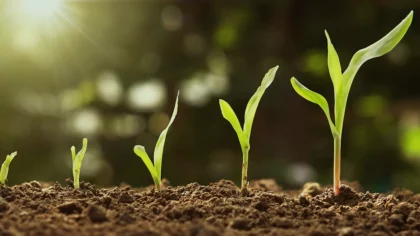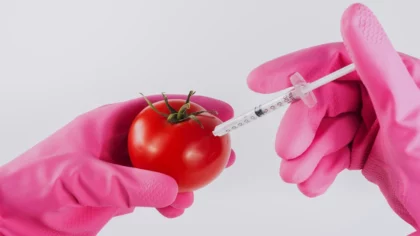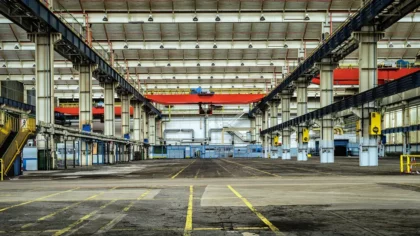Precision farming techniques, the demand for real-time data analytics, and advancements in machine learning are the key factors driving growth for AI in agriculture. The global AI market in agriculture is projected to reach USD 4.7 billion by 2028, with a compound annual growth rate (CAGR) of 23.1%.
In this strategic guide, you will explore the top 10 areas to implement AI in agriculture workflows. Additionally, you’ll discover key benefits, emerging solutions, and AI tools improving the operational efficiency, sustainability, and revenue of farming practices.
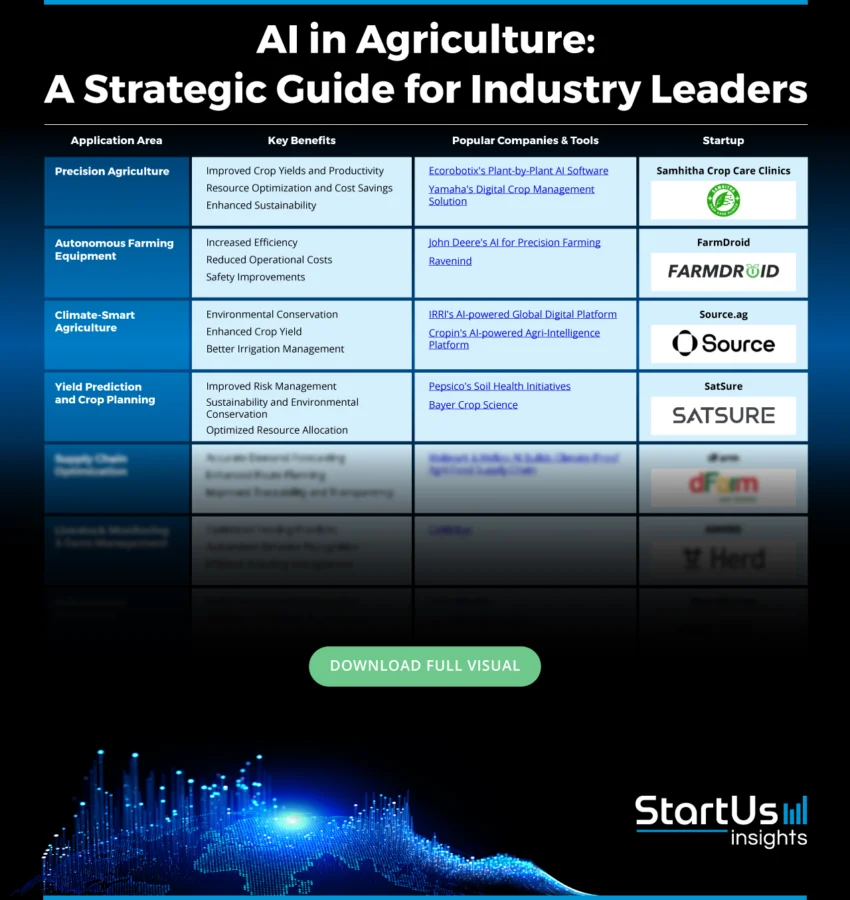
Key Takeaways
- Outlook and Economic Impact of AI: AI adoption is evolving across farm sizes with significant economic gains, including 150% ROI, 25% higher yields, and major improvements in resource efficiency.
- 10 Key Areas Where AI is Transforming Agriculture
- Key Drivers: Climate challenges, rapid technological breakthroughs, and mounting sustainability regulations are accelerating the global adoption of AI in agriculture.
- Future Outlook: AI is reshaping agriculture with fully autonomous farm machinery, virtual agronomists powered by generative AI, and verified carbon farming.
How Do We Research and Where is This Data From?
We reviewed 3100+ industry innovation reports to extract key insights and construct a comprehensive guide for integrating AI in agricultural operations. To increase accuracy, we cross-validated this information with external industry sources.
Additionally, we leveraged the StartUs Insights Discovery Platform – an AI and Big Data-powered innovation intelligence tool covering over 5 million startups and more than 20K+ technologies & trends worldwide to:
- Confirm our findings using the Trend Intelligence feature.
- Gather market statistics for each technology.
- Identify startups for the “Spotlighting an Innovator” sections.
Current Outlook on the Adoption and Economic Impact of AI in Agriculture
Adoption Rates and Technology Adoption Curve
- Adoption Rate: 80% of agribusinesses recognize the potential benefits of implementing AI solutions, but only 20% have fully adopted these technologies.
- Technology Adoption Curve: Farm-management software is the most widely used among farmers, with 21% adoption, followed by 15% using remote-sensing and precision agriculture tools.
- Stakeholder-specific Adoption: 81% of large farms (>5000 acres) are willing to adopt AI solutions. 76% of medium farms (2000 to 5000 acres) are using or planning to use AI technologies. 36% of small farms (<2000 acres) plan to adopt AI technologies.
Benefits of AI in Agriculture: Financial Metrics and Cost Effectiveness
- Market Size: The AI in Agriculture market size is projected to grow to USD 4.7 billion by 2028 with a CAGR of 23.1% from 2023 to 2028.
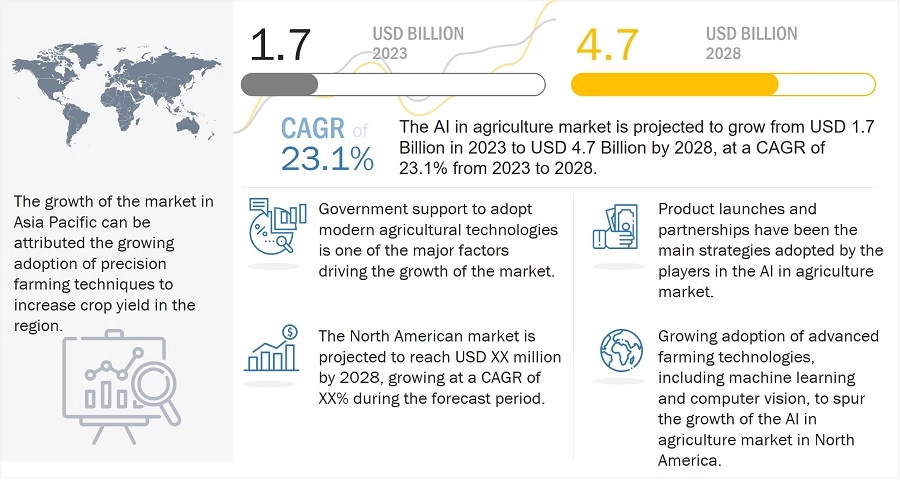
Source: MarketsandMarkets
- Clinical Outcome Metrics: A 25% increase in crop yields and a 50% reduction in pest losses following the implementation of AI in agriculture.
Average Crop Yield and Pest Loss Reduction
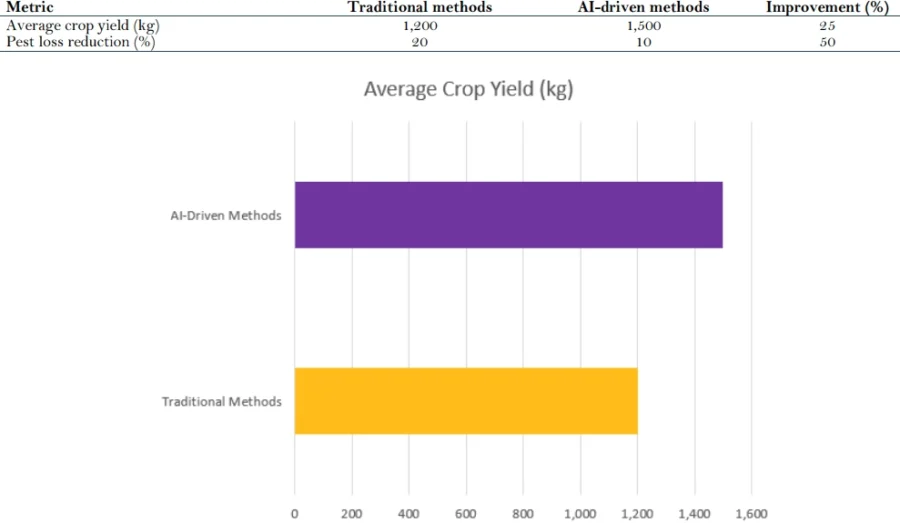
Source: Journal of Management World
- Cost Effectiveness Ratios: Small farmholders achieved a 120% return on investment (ROI) from AI adoption. Whereas, large-scale farmers reached 150% ROI from AI implementation.
ROI and Cost Savings by Farmer Type
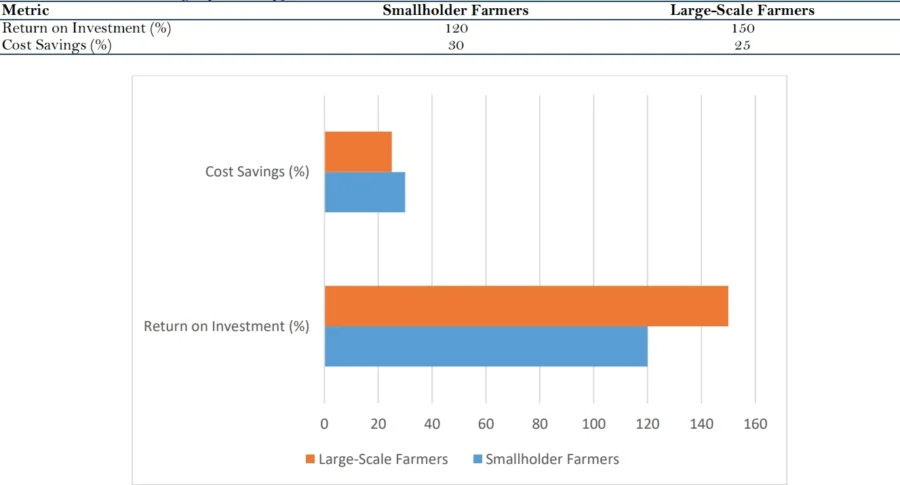
Source: Journal of Management World
- Indirect Economic Effects: AI-powered precision agriculture improves efficiency in water usage by 80%, while 85% accuracy is increased in fertilizer application due to AI-driven systems.
10 Areas to Implement AI in Agriculture Companies [2025 & Beyond]
1. Precision Farming
One of the primary uses of AI in farming is precision agriculture, a market projected to reach USD 11.14 billion by 2032 with a CAGR of 21%.
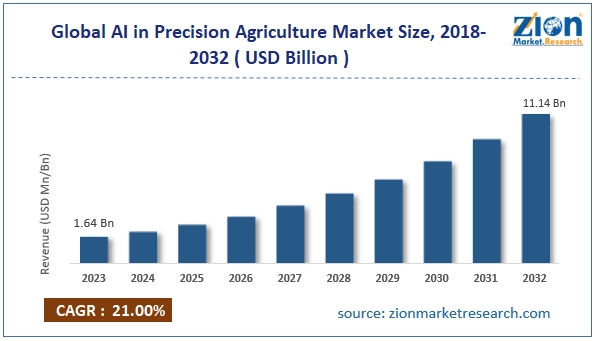
Source: Zion Market Research
Drones and satellites equipped with multispectral cameras and AI analyze crop health to identify variations in soil moisture, nutrient levels, and pest infestations. This facilitates targeted interventions. For example, thermal imaging processed via Intel’s OpenVINO toolkit detects microbial outbreaks early.
Smart irrigation systems further leverage soil moisture sensors and weather data to automate water distribution. Frosty Vineyards in Napa Valley used an AI-powered irrigation system to reduce water consumption by 30% and boost grape yield significantly.
Even the COALA project in Australia achieved a 20% increase in irrigation efficiency by using artificial intelligence in precision agriculture. Moreover, Bayer and EY’s implementation of AI in precision farming led to savings of up to USD 25 per acre each season.
Key Benefits
- Improved Crop Yields and Productivity: AI-driven tools analyze soil composition, weather patterns, and crop health to provide farmers with actionable insights. This enables targeted fertilization and pest control.
- Resource Optimization and Cost Savings: By facilitating precise application of inputs like water, fertilizers, and pesticides, AI minimizes waste and reduces costs.
- Enhanced Sustainability: AI-driven precision agriculture promotes sustainable farming by reducing the overuse of chemicals and optimizing water usage. This preserves environmental quality and ensures long-term agricultural viability.
Popular Companies and Tools
Ecorobotix’s Plant-by-Plant AI Software
Ecorobotix’s AI-driven platform enhances precision agriculture using its plant-by-plant recognition technology. It utilizes computer vision and machine learning algorithms to identify crops and weeds at the individual plant level. This targeted analysis enables ultra-localized herbicide application and reduces chemical use by up to 95%.
Yamaha’s Digital Crop Management Solution
Yamaha’s digital crop management platform combines AI, automation, and robotics to optimize large-scale farming operations. Its sensor-based monitoring and AI-powered analytics assess crop growth, predict yields, and automate labor-intensive tasks.
The platform is scalable and targets efficiencies in US specialty crop production. It streamlines workflows and reduces reliance on manual labor across diverse growing environments.
Spotlighting an Innovator: Samhitha Crop Care Clinics
Samhitha Crop Care Clinics is an Indian company that offers a precision farming advisory platform that integrates multi-layered agri-data collection with real-time crop monitoring.
It combines on-ground field visits, below-ground soil sensors, and above-ground aerial surveillance through drones and satellite imagery to gather environmental and crop-specific parameters in each growth stage.
The system connects farmers, field assistants, and expert advisors through a digital framework that enables localized decision-making and timely interventions. It incorporates tools like geo-tagged plot data, weather analytics, crop models, and soil health records to generate actionable insights.
By delivering tailored agronomic recommendations, Samhita Crop Care Clinics supports farmers in improving productivity, profitability, and long-term soil health.
2. Autonomous Farming Equipment
AI-driven autonomous farming equipment is expected to reduce labor costs. Autonomous tractors with GPS, computer vision, and deep learning detect obstacles and navigate easily. This improves planting accuracy.
Tractors integrated with AI optimize spraying practices based on foliage detection. This reduces unnecessary chemical use. AI-powered robotic harvesters and automated planters also reduce the incidence of musculoskeletal injuries among farmers.
The global autonomous farm equipment market size is forecasted to reach around USD 128.42 billion by 2034, with a CAGR of 5.9% from 2025 to 2034.
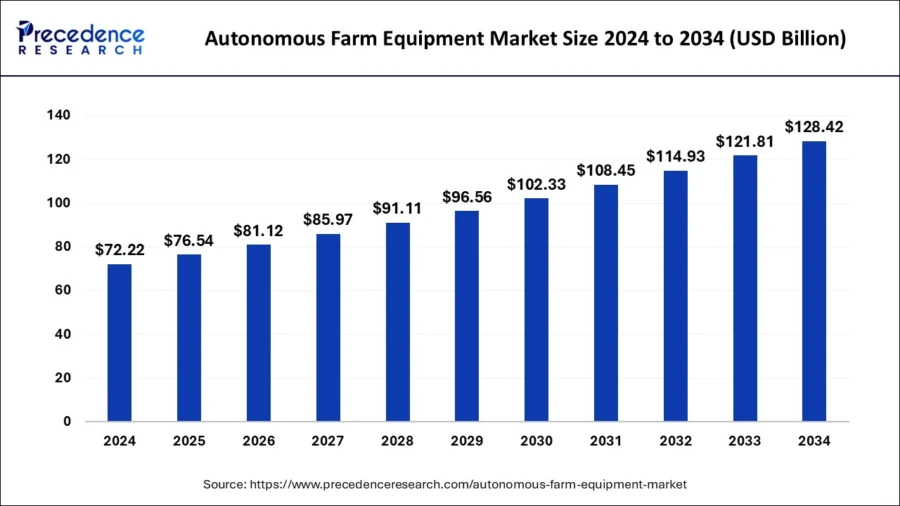
Source: Precedence Research
Key Benefits
- Increased Efficiency: Autonomous tractors and harvesters integrated with AI optimize planting, spraying, and harvesting. This leads to more precise and timely field operations that boost overall farm productivity.
- Reduced Operational Costs: By automating labor-intensive tasks, AI-driven machinery addresses labor shortages and lowers associated costs. Additionally, precise application of inputs like fertilizers and pesticides minimizes and reduces expenses.
- Enhanced Safety and Reduced Accidents: Autonomous equipment equipped with AI and sensor technologies detects and navigates around obstacles. This reduces accidents and enhances the safety of farm workers.
Popular Companies and Tools
John Deere’s AI for Precision Farming
John Deere integrates artificial intelligence, computer vision, and robotics into its autonomous farming machinery to enable real-time field decision-making.
Its AI-powered equipment, such as the autonomous 8R tractor, uses GPS guidance, sensor fusion, and machine learning to perform tasks like tillage and planting. The system continuously monitors field conditions, detects obstacles, and adjusts operations on the go.
Raven Industries’ Path to Autonomy
Raven Industries offers a scalable autonomy platform that transitions traditional machinery toward fully autonomous operation. Through GPS-guided steering, perception systems, and AI-based decision engines, Raven’s technology enables autonomous navigation, task execution, and fleet coordination.
Its modular approach supports phased automation and allows farmers to incrementally adopt advanced capabilities for spraying, planting, and harvesting.
Spotlighting an Innovator: FarmDroid
FarmDroid is a Danish company that manufactures an autonomous field robot to perform sowing and mechanical weeding, powered by solar energy. It operates using high-precision GPS and records seed placement during sowing. It later returns to mechanically weed between and within crop rows without relying on cameras or sensors.
The robot functions without fossil fuels and ensures day and night operation through solar-charged batteries by enabling continuous and energy-efficient field coverage. It maintains low soil compaction due to its lightweight design and allows farmers to reduce herbicide use and manual labor costs.
3. Climate-Smart Agriculture
The integration of AI into climate-smart agriculture offers measurable improvements in productivity, sustainability, and climate resilience.
AI in farming is driving real impact on the field. AI-based interventions increase crop yields by up to 25% by optimizing input use and enhancing crop resilience. Additionally, smart irrigation systems reduce water consumption by as much as 40% without compromising output.
These technologies also minimize environmental impact. For example, AI-based insect surveillance reduces pesticide application by 30%. AI-powered decision support systems further strengthen climate adaptation by using crop yield prediction models and enabling more accurate weather forecasting.
CSA supports a 30 to 50% reduction in carbon emissions and a 20 to 35% increase in soil organic carbon stocks. Smart Farm Agritech reports a 25% water savings, while Organic Orchard improves soil health through AI-driven disease detection.
Key Benefits
- Environmental Conservation: AI-driven precision agriculture enables the efficient use of resources, minimizes waste, and reduces environmental impact. This approach preserves soil health and decreases chemical runoff.
- Enhanced Crop Yield Prediction: By analyzing weather patterns, soil conditions, and historical crop performance, AI models accurately forecast crop yields. These predictions assist farmers in resource allocation to improve food security and market stability.
- Early Detection: Utilizing advanced image recognition and sensor technologies, AI systems identify signs of crop stress, diseases, and pest infestations at early stages.
Popular Companies and Tools
IRRI’s AI-Powered Global Digital Platform
The International Rice Research Institute (IRRI) has launched an AI-powered platform to accelerate hybrid rice breeding and enable climate-resilient crop development. Leveraging machine learning and big data analytics, the platform predicts optimal parental combinations and streamlines trait selection across diverse environments.
By reducing breeding cycles and improving varietal precision, the platform supports global efforts to develop rice varieties that withstand climate stresses like drought, salinity, and heat.
Cropin’s AI-powered Agri-Intelligence Platform
Cropin’s SAGE platform combines artificial intelligence, geospatial data, and crop models to deliver real-time insights for climate-resilient farming. It processes field-level data to predict crop performance, assess risks, and guide climate-smart interventions across the agri-value chain.
SAGE enables early warning systems, adaptive planning, and resource-efficient decision-making that strengthens food security and climate adaptation strategies.
Spotlighting an Innovator: Source.ag
Source.ag is a Dutch startup that develops an AI-driven greenhouse management platform to support climate-resilient and resource-efficient horticulture. It integrates real-time data from climate sensors, crop growth parameters, and irrigation systems to simulate, optimize, and autonomously execute cultivation strategies.
The platform leverages Source Workspace for centralized data management, harvest forecast, cultivation management, and irrigation control. This ensures optimal growth, precision fertigation, and streamlines operations in greenhouses.
The platform’s AI models continuously adapt to local conditions and grower goals to improve yield predictability, reduce resource inputs, and enhance operational decision-making.
4. Yield Prediction and Crop Planning
AI-driven models have shown a 15% improvement in yield prediction accuracy compared to traditional methods. Such models combine historical crop yield data, satellite imagery, weather patterns, and soil conditions.
Advanced machine learning algorithms like Random Forest, support vector machines (SVMs), and neural networks forecast crop yields with high precision.
Remote sensing technologies, including satellite imagery and geospatial data, further strengthen these models by offering real-time insights into crop health and environmental conditions.
AI systems are successfully deployed to predict wheat growth stages and tomato ripeness to improve operational efficiency. Beyond the farm, accurate yield predictions improve food security by enabling policymakers to manage supply chains and allocate resources effectively.
The US Corn Belt, where random forest and gradient boosting regressions are used for corn yield prediction, demonstrates the practical value of these technologies.
Key Benefits
- Improved Risk Management: AI models enable farmers to implement proactive strategies by analyzing diverse data, like weather patterns, soil conditions, and historical yields, to forecast risks like droughts or pest infestations.
- Sustainability & Environmental Conservation: By providing precise recommendations on input usage and crop rotation, AI supports sustainable farming practices. This reduces the overuse of fertilizers and pesticides.
- Optimized Resource Allocation: AI-driven insights assist farmers in efficiently allocating resources like water, fertilizers, and labor based on real-time field data.
Popular Companies and Tools
PepsiCo India’s AI-driven Soil Health Initiatives
PepsiCo India combines AI and soil health monitoring to enhance yield prediction and crop planning in potato farming. By analyzing satellite imagery, soil nutrient data, and historical crop performance, it provides tailored agronomic advisories to farmers.
The initiative improves input efficiency, optimizes planting schedules, and supports sustainable crop rotation to ensure higher yields.
Bayer Crop Science’s AI and Data Science Platform
Bayer Crop Science leverages generative AI and predictive analytics to optimize seed selection, planting strategies, and crop planning. Its data-driven platform analyzes weather data, soil parameters, and historical yields to simulate crop outcomes and recommend high-performing combinations.
Spotlighting an Innovator: SatSure
SatSure is an Indian company that offers a yield prediction and crop planning platform that integrates satellite imagery with machine learning and multi-source datasets to deliver field-level agricultural insights.
It processes high-resolution earth observation data alongside weather patterns, soil moisture levels, market prices, and socioeconomic indicators to model crop health, growth stages, and potential yield outcomes.
The platform also offers geospatial intelligence to support risk assessment, sow advisories, acreage estimation, and harvest forecasts in large and fragmented farmlands. This allows stakeholders to improve planning accuracy, optimize resource use, and strengthen climate resilience.
5. Supply Chain Optimization
Farmers and businesses integrate AI into agricultural supply chains to enhance efficiency, reduce waste, and promote sustainability. AI predicts optimal planting times to improve yield potential while mitigating risks associated with weather variability.
For instance, AI advisory services have resulted in a 25% increase in yields by recommending optimal seed varieties based on weather patterns. This simplifies decision-making for farmers.
Combining AI with blockchain and IoT increases transparency and optimizes transportation routes to improve product quality through the supply chain.
Supply chain optimization platforms integrated with AI offer demand forecasting and price prediction. By analyzing historical data and market trends, AI systems prevent overproduction or shortages, reduce waste, and ensure the timely delivery of agricultural products.
Integrating AI into agricultural supply chains also aids in early risk detection, like financial instability or delivery delays. This enhances the resilience and efficiency of agricultural supply chains and benefits producers and consumers alike.
Key Benefits
- Accurate Demand Forecasting: AI-powered predictive analytics solutions forecast market demand to optimize harvesting, storage, and distribution schedules. This reduces overproduction and minimizes waste.
- Enhanced Route Planning: AI algorithms analyze weather conditions, traffic patterns, and delivery schedules to determine the most efficient transportation routes. This ensures the timely delivery of agricultural products.
- Improved Traceability & Transparency: Combining AI with blockchain enables real-time agricultural product tracking from farm to table. This enhances food safety, ensures compliance with regulations, and builds consumer trust.
Popular Companies and Tools
Walmart & Helios AI’s Climate-Proof Agri-Food Supply Chain
Walmart, in collaboration with Helios AI, is leveraging an AI-powered platform to build climate-resilient agri-food supply chains. It uses predictive modeling, satellite data, and environmental analytics to anticipate climate risks and identify vulnerable links across global sourcing networks.
The platform forecasts yield disruption, optimizes procurement routes, and enables adaptive logistics. This improves supply chain transparency and ensures consistent product availability in the face of climate volatility.
Spotlighting an Innovator: dFarm
dFarm is a US-based startup that offers a supply chain optimization platform that connects stakeholders in the agricultural value chain through AI-driven analytics and real-time data exchange.
It operates using AIMS, a distributed enterprise resource planning (ERP) system that utilizes blockchain to record and calculate production costs instantly while tracking compliance with FSMA 204 regulations.
The platform integrates data from farms, warehouses, and retailers to enable end-to-end traceability, monitor freshness and quality, and reduce post-harvest losses.
dFarm thus supports producers and distributors in enhancing food safety, minimizing spoilage, and improving cost control across perishable goods networks.
6. Livestock Monitoring and Farm Management
Wearable devices equipped with sensors collect data on vital signs, activity levels, and feeding behaviors. For example, dairy farmers in the US utilize internet-connected collars and ear tags to track cows’ movements and behaviors. AI-powered systems leverage this data to analyze animal health in real time and optimize animal husbandry operations.
Computer vision solutions analyze livestock behavior to identify signs of stress, discomfort, or injury. AI-powered models analyze data from cameras that are installed in barns to monitor animal movements. It also offers insights into feeding patterns, social interactions, and overall well-being.
For instance, Merck Animal Health’s SenseHub utilizes wearable sensors to provide real-time data on livestock health and behavior. This data is analyzed by AI algorithms to enhance herd management practices and facilitate prompt treatment decisions.
AI further facilitates precision feeding by analyzing individual animals’ nutritional needs based on age, weight, and health status. Advanced feed formulation software uses conversational AI to create customized nutrition plans for livestock.
Machine learning algorithms assist in identifying optimal breeding times by monitoring behavioral and physiological indicators of fertility. This allows farmers to predict estrus cycles and ideal times for insemination for higher reproductive success rates.
Key Benefits
- Optimized Feeding Practices: AI-powered systems analyze animal weight, age, and production goals to dispense precise feed portions. This ensures balanced nutrition and reduces waste.
- Automated Behavior Recognition: Utilizing sensors and computer vision, AI monitors livestock behavior in real time and detects deviations that may indicate health issues or stress.
- Efficient Breeding Management: AI analyzes data, like milk composition and body temperature, to accurately predict fertility cycles. It recommends optimal breeding times and genetic matches to improve reproductive efficiency.
Popular Companies and Tools
CattleEye’s AI-powered Livestock Monitoring Platform
CattleEye uses computer vision and machine learning to deliver autonomous monitoring of dairy cattle through standard security cameras. Its AI platform analyzes gait, posture, and behavior to detect early signs of lameness and other health issues without the need for wearable sensors.
The platform offers real-time insights into animal well-being and supports farmers in improving herd health while reducing treatment costs.
Spotlighting an Innovator: AIHERD
AIHERD is a French company that develops livestock monitoring and farm management solutions. It utilizes artificial intelligence to conduct real-time visual analysis of bovine farms without wearable devices.
By tracking subtle changes in movement, social interactions, and health markers, AIHERD detects early signs of illness and accurately identifies heat cycles through behaviors like the Flehmen response.
7. Soil and Crop Monitoring
AI-integrated sensors assess soil health by measuring moisture levels, nutrient content, and pH in real time. They provide instant feedback for implementing soil management strategies effectively. AI-driven soil testing, for example, can be customized to specific crop requirements based on farm size and soil type.
AI also detects early signs of crop diseases and nutrient deficiencies. AI-driven tools like bot advisors and digital platforms have doubled the income of smallholder farmers in India by improving crop yields.
Solinftec, an ag-tech company, has introduced Solix Ag Robotics, an autonomous robot equipped with solar panels. It analyzes plant health, assesses nutritional content, searches for weeds, and detects evidence of insect damage.
Its AI-based analytics solution also monitors and evaluates crop health utilizing weather, soil moisture, and satellite data for wheat and rice cultivation.
Further, Farmonaut helped over 200 000 farmers worldwide by providing insights into crop health, soil conditions, and farm performance. The platform reduces costs by 25% and increases efficiency by 30%.
Key Benefits
- Early Disease & Pest Detection: Advanced algorithms analyze images from drones and satellites to identify early signs of diseases and pest infestations in crops. This reduces crop losses and the need for extensive chemical treatments.
- Real-Time Soil Health Assessments: AI-powered sensors and remote sensing technologies provide continuous soil monitoring of moisture levels, nutrient content, and pH. This real-time data allows farmers to make informed decisions on irrigation, fertilization, and crop rotation.
- Yield Prediction: By analyzing historical data, weather patterns, and current crop health indicators, AI models accurately forecast crop yields. These predictions assist farmers in planning harvests, managing storage, and making informed marketing decisions.
Popular Companies and Tools
AI4SoilHealth’s AI-driven Soil Monitoring Platform
AI4SoilHealth leverages artificial intelligence and open science for soil health monitoring. The company’s platform integrates AI models with satellite imagery, in-field sensor data, and standardized soil metrics to provide actionable insights.
The insights on soil organic carbon, nutrient levels, and degradation risks empower farmers and researchers to adopt regenerative practices and improve long-term land productivity.
Cropler’s AI-powered Agri-Camera System
Cropler’s agri-camera solution combines machine vision and AI to monitor crop health and development directly in the field. It captures continuous, high-resolution images of crops and uses deep learning to assess stress indicators, detect pests, and evaluate growth stages.
Operating autonomously without internet dependency, the solution delivers timely alerts and predictive analytics to optimize inputs and increase harvest quality and yield.
Spotlighting an Innovator: Map My Crop
Map My Crop is a US-based startup that develops a soil and crop monitoring platform. The platform combines satellite imagery, drone data, and AI models to provide real-time, sensor-free insights across diverse agricultural landscapes.
The platform processes multi-source inputs, like 1-meter resolution imagery, 100-meter weather data, and crop-specific parameters. These data points are utilized to detect farm boundaries, classify soil types, assess water stress, and identify disease risks.
The platform supports farm, tree, and forest monitoring while automating crop detection and irrigation modeling without physical infrastructure. It simplifies information delivery through multilingual WhatsApp reports and offers access via web, mobile, and APIs for farmers, enterprises, and institutions.
8. Pest and Disease Management
AI for agriculture is transforming how farmers detect and manage crop diseases and pests. AI-powered image recognition systems analyze visual data from crops to identify early signs of pest infestations and diseases.
For instance, the Plantix mobile application utilizes deep learning to recognize and classify images of symptomatic crops. It accurately identifies over 120 plant pests and diseases across 30 crop types to enable timely diagnoses and prompt interventions to mitigate crop damage.
Integrating AI into integrated pest management (IPM) systems also enhances the ability to predict and prevent pest outbreaks. AI models forecast pest population dynamics and disease emergence.
AI-based drones equipped with imaging sensors detect early disease symptoms in crops like cashew farming. These drones then apply precise amounts of pesticides only to affected areas to minimize chemical usage and environmental impact.
In Kenya, small-scale farmers are utilizing AI tools like Virtual Agronomist and PlantVillage to receive tailored advice on fertilization and pest control. This leads to increased productivity and reduced costs. For instance, farmer Sammy Selim nearly tripled his coffee yield after implementing recommendations using Virtual Agronomist.
Key Benefits
- Early Detection & Diagnosis: AI tools analyze drone and sensor data to identify early signs of pest infestations and crop diseases. This enables timely interventions and minimizes reliance on chemical treatments.
- Automated Monitoring: AI-powered tools continuously monitor crop fields to detect and quantify pest populations and disease spread. This reduces the need for manual field inspections and provides real-time insights for effective management strategies.
- Precision Pest Control: Smart tools ensure targeted pest control by analyzing data to determine optimal treatment areas and methods. This precision reduces pesticide usage, lowers costs, and minimizes environmental impact.
Popular Companies and Tools
Plantix & NN Running Team’s AI-Powered Pest Management
Plantix, in collaboration with the NN Running Team, developed an AI-powered mobile app to improve pest and disease management in African agriculture. The app uses image recognition and machine learning to diagnose crop issues from smartphone photos and offers instant treatment recommendations.
This partnership supports smallholder farmers with accessible, real-time crop protection guidance and improves resilience against climate-driven pest outbreaks.
Solinftec’s AI-driven Weed-Killing Robots
Solinftec’s autonomous bots use AI and computer vision to detect and eliminate weeds with high precision during field operations. The robots integrate real-time imaging and neural networks to differentiate between crops and weeds and apply herbicide only where needed.
This targeted approach minimizes chemical use, protects soil health, and makes autonomous weeding a scalable solution for sustainable agriculture.
India’s National AI Pest Surveillance System
The Indian government’s AI-enabled national pest surveillance system combines remote sensing, machine learning, and real-time field data to forecast pest outbreaks across major agricultural zones.
By analyzing weather patterns, crop stages, and historical pest data, the platform delivers early warnings and localized advisories to farmers. This reduces crop losses, optimizes pesticide usage, and modernizes India’s crop protection infrastructure through proactive surveillance.
Spotlighting an Innovator: Fermata
Fermata is an Israeli company that offers an AI-powered pest and disease management system for greenhouses and indoor farms. It deploys computer vision algorithms through its Croptimus platform to analyze visual data captured from cameras installed across cultivation areas.
The platform continuously monitors crops at scale to identify anomalies before they escalate, and provides growers with real-time alerts and actionable insights. Its non-invasive setup reduces manual scouting efforts and supports a range of crops without hardware modifications.
In this way, Fermata improves detection accuracy and allows growers to protect plant health, reduce crop loss, and optimize overall productivity.
9. Irrigation Management
AI-powered irrigation systems analyze real-time data from soil moisture sensors, weather forecasts, and crop requirements to determine precise watering schedules. The technology ensures crops receive the optimal amount of hydration.
For instance, AI-driven irrigation reduces water usage by up to 50% while improving crop yields by 30%.
Such technologies, integrated with sensors and weather forecasts, enable farmers to predict water availability and crop needs. The adoption of AI in irrigation management is gaining momentum among both large-scale agricultural enterprises and individual farmers.
For example, Microsoft’s AI-powered FarmBeats platform integrates data from various sensors to optimize irrigation practices and more sustainable agriculture.
Key Benefits
- Optimized Water Usage: Smart systems analyze real-time data on soil moisture, weather conditions, and crop requirements to deliver precise irrigation. This approach improves water resources and crop yields.
- Leak Detection and Prevention: Intelligent monitoring tools quickly detect and alert farmers to leaks or inefficiencies in irrigation systems.
- Automated Irrigation Scheduling: AI algorithms develop dynamic irrigation schedules that adapt to changing environmental conditions and crop needs. This ensures optimal watering times.
Popular Companies and Tools
GroGuru’s Wireless Soil Sensor Probe
GroGuru develops a wireless underground soil sensor system for continuous root zone monitoring in annual field crops. The AI-enabled probe collects real-time data on soil moisture, temperature, and salinity at multiple depths without disrupting field operations.
By providing accurate insights into crop water needs, the system empowers farmers to optimize irrigation timing and quantity. This improves water efficiency and boosts yield while conserving resources.
Full Nature Farms’ Smart Irrigation System
Unveiled at CES 2025, Full Nature Farms’ AI-powered smart irrigation system leverages real-time weather data, soil conditions, and plant growth metrics to automate water delivery with high precision. The system utilizes machine learning algorithms that adapt to changing environmental variables and reduce agricultural water waste by up to 40%.
Spotlighting an Innovator: AgWise
AgWise is an Indian startup that provides an irrigation management platform by integrating conversational AI and IoT to deliver field-specific recommendations. It collects real-time environmental and crop data using IoT devices and combines it with agronomic models to generate dynamic irrigation schedules.
The platform enables farmers to interact via AI-powered chat interfaces in local languages and receive personalized guidance on irrigation timing, volume, and nutrient delivery. By merging data-driven insights with farmer-centric communication, the company allows farms to increase water efficiency, reduce input costs, and improve crop productivity.
10. Plant Breeding and Gene Editing
Smart technology facilitates the analysis of complex genetic data to identify desirable traits and predict plant performance under various environmental conditions.
Norwich Research Park has developed TraitSeq, an AI-driven software that utilizes RNA sequencing and machine learning to identify biomarkers. This tool predicts optimal performance traits in crops across different environments and streamlines the breeding process.
Additionally, AI supports phenotyping by employing machine learning algorithms and image recognition techniques. This improves accuracy in the identification of plant species, early disease diagnosis, and crop yield prediction.
The integration of AI with gene editing technologies, such as CRISPR-Cas9, further enhances the precision and efficiency of genetic modifications. AI algorithms quickly identify target genes associated with desirable traits and design guide RNAs for CRISPR applications.
This synergy accelerates the development of crop varieties with improved characteristics like increased yield, disease resistance, and climate adaptability.
Key Benefits
- Accelerated Breeding Cycles: AI models analyze extensive genomic and phenotypic data to swiftly identify desirable traits. This addresses food security challenges in the face of climate change.
- Precision Gene Editing: By predicting optimal gene targets, AI enhances the accuracy and efficiency of gene-editing tools like CRISPR-Cas9. This allows for the development of crops with specific, beneficial traits and reduces off-target effects.
- Disease & Climate-Resilient Crops: AI identifies genetic variations that confer resistance to diseases and environmental stresses. This enables farmers to maintain agricultural productivity amid evolving climatic conditions.
Popular Companies and Tools
Heritable Agriculture’s AI-guided Crop Breeding Platform
Heritable Agriculture, a Google spinout, applies artificial intelligence to accelerate trait discovery and crop breeding. The platform uses large-scale genomic data, climate variables, and machine learning to identify gene-trait relationships and predict high-performing plant varieties tailored to specific environments.
By streamlining the breeding cycle and improving accuracy in varietal selection, Heritable Agriculture develops climate-resilient and high-yield crops at speed and scale.
Spotlighting an Innovator: Verinomics
Verinomics is a US-based startup that offers a plant breeding and gene editing platform. It combines genomics, computational biology, and precision transgene-free editing to accelerate crop improvement.
The platform analyzes genetic variation in germplasm and uses proprietary algorithms to identify, predict, and introduce beneficial traits without altering native DNA structures.
The platform enables rapid, non-GMO trait development that aligns with global regulatory standards. It enhances disease resistance, sustainability, and nutritional value. Collaborations with germplasm providers reduce breeding cycles while preserving varietal identity.

Key Drivers Leading to the Adoption of AI in the Agriculture Industry
1. Climate Change and Resource Scarcity
As we experience an increase in climate variability with diminishing natural resources, AI-driven technologies optimize the use of water, fertilizers, and pesticides. AI-driven irrigation systems reduce water consumption by 25% while targeted pesticide applications lower chemical usage by 20%.
In Switzerland, AI-powered drones monitor soil moisture and nutrient levels that minimize waste and environmental impact.
2. Technological Advancements
Gen-AI offers actionable insights by analyzing satellite imagery and weather forecasts to agronomists and researchers. Platforms, like Agmatix’s leafy AI, provide real-time recommendations for crop management and validate the efficiency of biologicals.
Moreover, agentic AI autonomously analyzes diverse data sources to converse, understand, reason, and act upon information to offer cost-effective solutions. Cropin Sage integrates and structures unstructured data to deliver predictive intelligence for pest forecasts and yield estimations.
AI-powered drones in the US and Switzerland detect early signs of pests, disease, and nutrient deficiencies.
3. Sustainability and Regulatory Pressures
Regenerative agriculture practices prioritized for soil health and biodiversity rely on AI to monitor carbon sequestration and reduce greenhouse gas emissions. For instance, farmers across the globe are leveraging AI-driven predictive models to forecast crop yields, optimize rotations, and stay aligned with global sustainability goals.
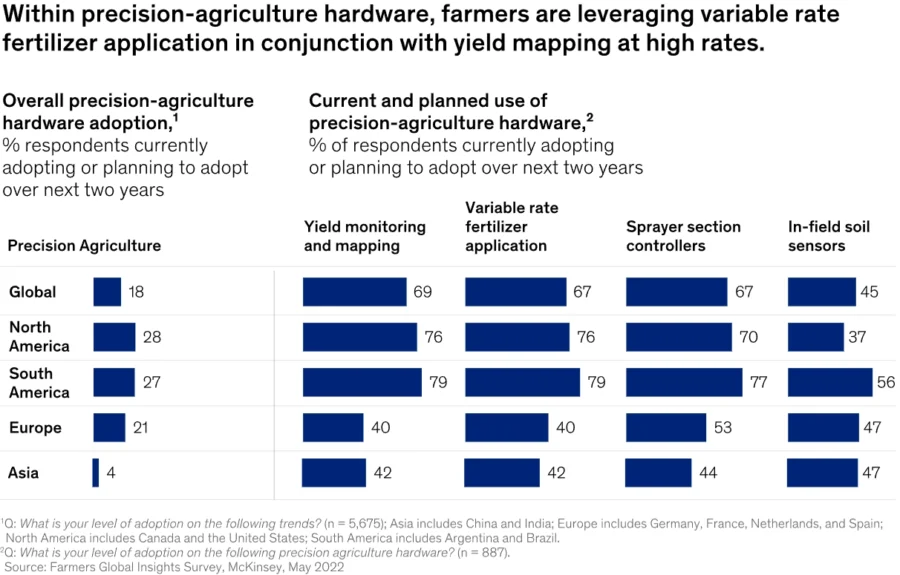
Source: McKinsey & Company
Canada’s 2030 Emission Reduction Plan aims to lower emissions from fertilizers and drive AI-based precision agriculture technologies. Also, Europe’s proposed Green Deal focuses on reducing agricultural inputs. This is expected to boost the adoption of farm management software and precision agriculture tools.
Future of AI in the Agriculture Industry: 3 Emerging Trends
AI-powered Autonomous Machinery
Autonomous tractors and drones equipped with Level 4 and 5 autonomy, combined with computer vision and deep neural networks, distinguish crops from weeds with 90% accuracy using green-on-green spraying techniques.
They perform automated planting and harvesting while dynamically adjusting engine load, tire pressure, and implementing settings based on real-time soil analysis.
Impact: Reduces labor costs and reduces chemical inputs by 30% while enhancing yield uniformity across vast plots.
Generative AI as Virtual Agronomists
Generative AI, powered by large language models (LLMs), is increasingly serving as the cognitive engine of modern farm operations. Platforms, like AGRIVI, analyze weather forecasts, soil composition, and market trends to deliver hyperlocal crop planning and risk assessment.
Another example – Syngenta’s GenAI tools serve as continuous agronomic advisors that provide instant recommendations for fertilization, irrigation, and pest control. These models forecast yield variability with up to 95% accuracy, even six months ahead of harvest.
Market Growth: The generative AI market in agriculture is projected to grow by 30.0% CAGR from 2025 to 2026. Therefore, it becomes an indispensable decision-support system for farmers and agri-enterprises.
Carbon Farming with AI Verification
Carbon farming with AI-driven measurement, reporting, and verification (MRV) platforms emerges as the backbone for credible carbon credit systems. Using satellite-based multispectral imaging and machine learning, these tools monitor soil carbon in real-time and automate credit certification processes.
Companies like ICL Group deploy AI to quantify carbon sequestration from regenerative practices.
Projection: By 2027, AI-verified carbon credit markets could provide farmers practicing regenerative agriculture with additional revenue ranging from approximately USD 3 to USD 30 per acre annually.
Finding the Best AI Solutions for Your Agriculture Business
With thousands of emerging AI technologies and startups, navigating the right investment and partnership opportunities is challenging.
With access to over 5 million emerging companies and 20K+ technologies & trends globally, our AI and Big Data-powered Discovery Platform equips you with the actionable insights you need to stay ahead of the curve.
Leverage this powerful tool to spot the next big thing in AI before it goes mainstream. Stay relevant, resilient, and ready for what is next.

![AI in Agriculture: A Strategic Guide for Industry Leaders [2025-2030]](https://www.startus-insights.com/wp-content/uploads/2025/03/AI-in-Agriculture-SharedImg-StartUs-Insights-noresize-420x236.webp)

![AI in Automotive: A Strategic Guide for Industry Leaders [2025-2030]](https://www.startus-insights.com/wp-content/uploads/2025/03/AI-in-Automotive-SharedImg-StartUs-Insights-noresize-420x236.webp)

![AI in Healthcare: A Strategic Guide for Industry Leaders [2025-2030]](https://www.startus-insights.com/wp-content/uploads/2025/03/AI-in-Healthcare-SharedImg-StartUs-Insights-noresize-420x236.webp)
